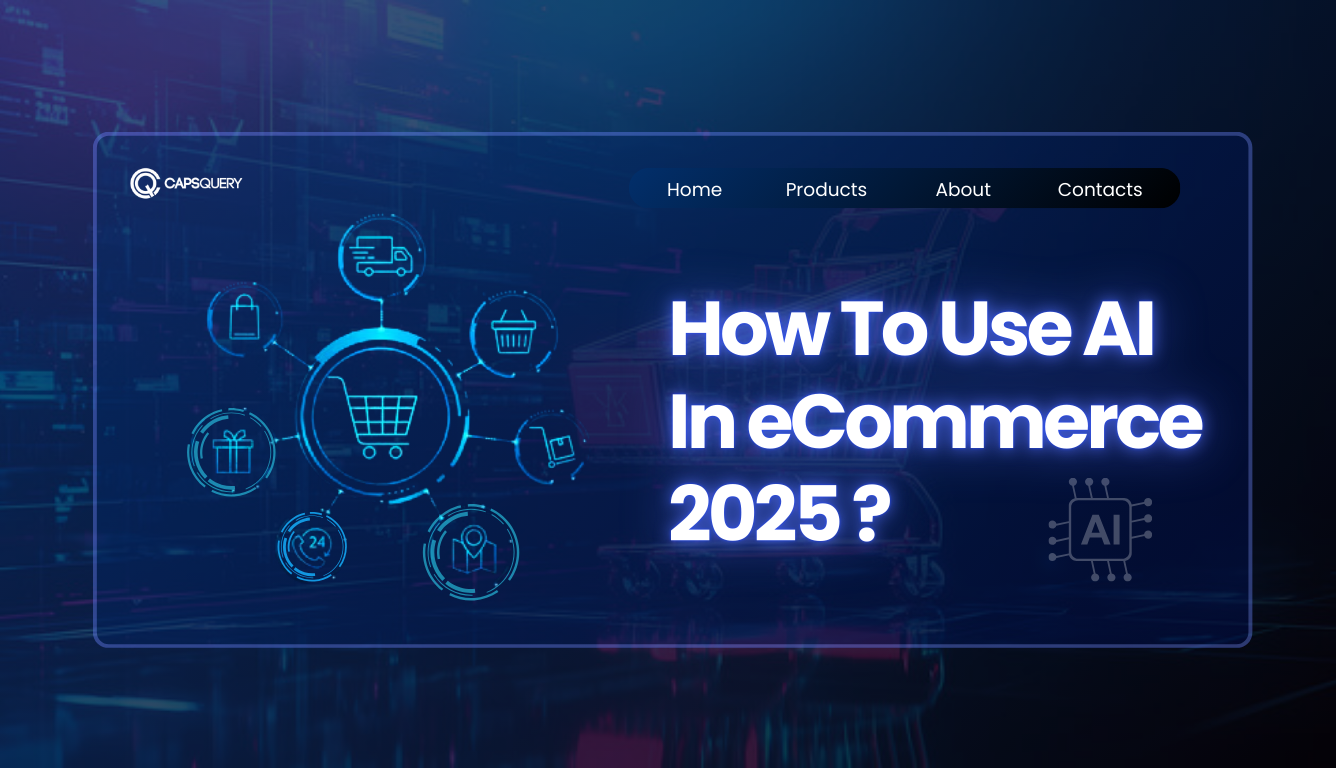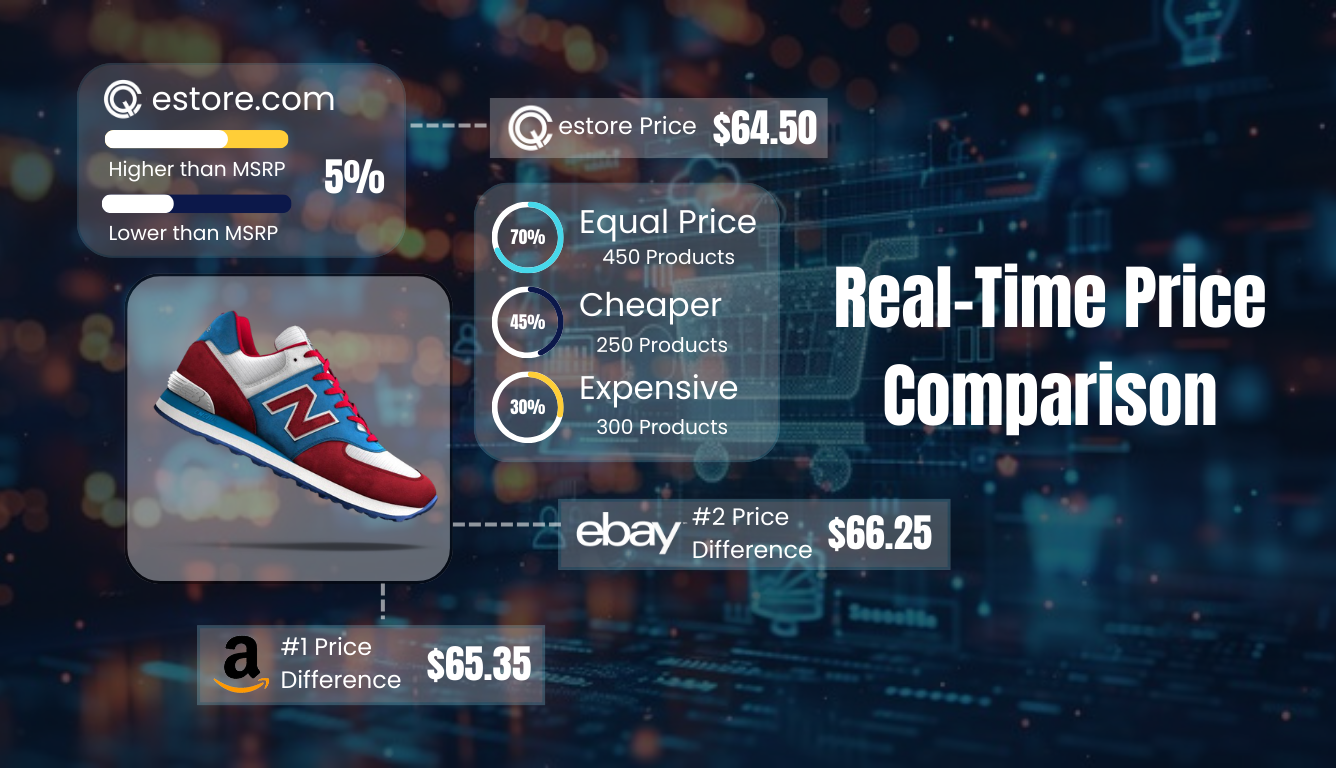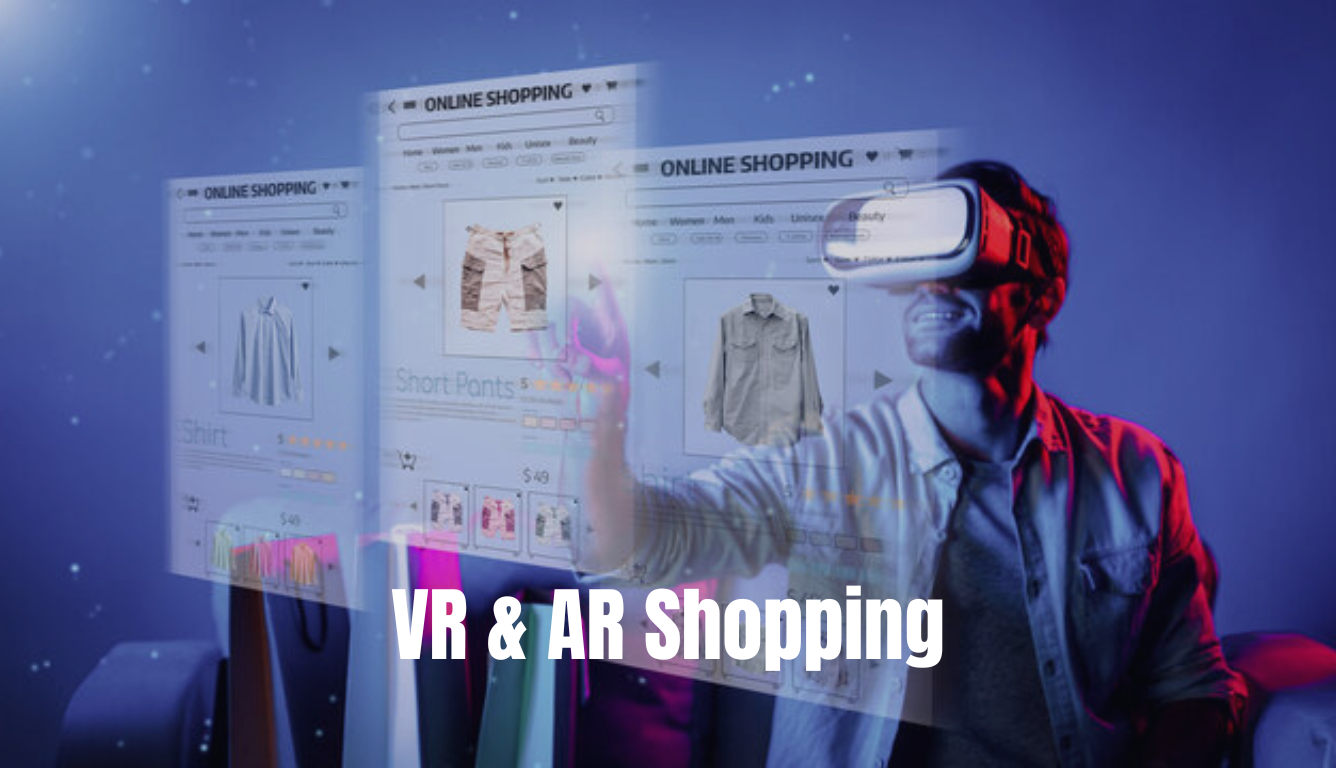







E-commerce is one of the effective markets embracing the contributions of AI to transform future operations for better performance. From inventory management automation and e-logistics to personalized product recommendations and AI-driven customer support, AI has become an indispensable part of eCommerce functioning. Even e-commerce giants like Amazon, Shopify, eBay, and more organizations are implementing AI features to enhance their online shopping experience. In this blog, we have specified the essential pointers on how to leverage AI to improve competitiveness. Let’s explore the true potentialities of AI in eCommerce in 2025.
In today’s time, customers value hassle-free and easy shopping experiences. Therefore, an eCommerce entity must provide an intuitive buying process, genuine product information, error-free checkout, and secure payment processing. So, introducing AI in eCommerce delivers specialized product suggestions to customers based on their previous purchase records, browsing history, preferences, and real-time behaviour. With AI-driven personalized product recommendations, you can highlight your trending items and relevant product details to customers that meet their requirements.


For instance, you can send notifications about new products or discount offers to individual customers on specific occasions using an AI-based personalized recommendation system. So, AI acts as an ultimate shopping assistant not only for customers but also helps businesses to improve upselling and cross-selling opportunities with several other benefits.
It mainly utilizes machine learning and deep learning algorithms to analyze customers’ purchasing data in real-time. So, the recommendation system works on recent clicks, added items to the cart, products on the wishlist, and viewed items. AI considers specific product attributes through keywords based on brands, product categories, and popular choices that match your searches to give on-spot suggestions. So, these are the key components that make the system more definite:
AI recommendation systems gather a customer’s information from different resources, such as user engagement time on a website, search queries, past purchases, and collaborative filtering. In this process, Python is also deeply involved in content-based filtering. By reviewing these behavioural data, AI fine-tunes and filters the content according to the collected data of individual customers and gives accurate results.
An eCommerce store contains a vast amount of data. Maintaining these data resources is vital for the smooth running of the website. Hence, Python provides an extensive range of ML-supported libraries like NumPy and Pandas that help with data transformation, cleaning, analysis, and model training. It is capable of handling and processing large datasets for training recommendation systems.
AI recommendation systems use Python and ML algorithms to process users’ historical data and preferences for predictive analysis. So, it anticipates items that customers want before searching on your eCommerce store. Python libraries like TensorFlow and PyTorch help in model training to make predictions and generate suitable recommendations in real-time.
Even a customer’s demographic location is an important element that AI uses to provide suggestions. It incorporates data like date and time of order, location of the user, market surveys, and other personal details to categorize a distinct user. You can use AI-driven hyper-personalization for product marketing and suggestions at different festivals across the globe to reach your target audience. For example, a person searching your eCommerce store in the US will not receive the same product recommendations at the time of Diwali or other regional-based festivals. So, this will change periodically through the AI automation process for better user engagement.
Machine learning and artificial intelligence have already enhanced the mode of personalized recommendation through visual search features. Now, users can search for their desired products online with pictures and screenshots. By taking a snap of the item, you can easily search for it on the eCommerce store to check availability. Therefore, you don’t have to waste time in product scrolling or describe in words what you are looking for. For example, Retailers can utilize visual search platforms like Google Lens, Amazon Camera Search, and Pinterest Lens to enable effortless shopping using images.


Just imagine a person finds an eye-catching home decor item in a store and takes a snap. Later, that individual uploads the picture and searches it through visual search tools to get the exact or a close one. So, using an AI-based visual search saves time and improves the customer shopping experience. For example, it is beneficial for individuals with hearing or speaking impairments to search for products without any dependencies.
The question is, how does AI-based visual search work in real-time? GenAI (Generative AI) plays an important role in transforming business models and startup opportunities. AI uses machine learning algorithms and image recognition processes to detect and analyze images and give us relevant content based on the provided data. Here’s a detailed explanation of a visual search system:
Computer vision is an AI-focused technology that aims to train a computer or machine to analyze images through deep learning and ML algorithms. Primarily, an image recognition or object detection system uses deep-learning models like R-CNN, YOLO, and SSD. The whole process goes through a few layers of neural networks, such as extraction, classification, and localization. Here, Python libraries like OpenCV, TensorFlow, PyTorch, Scikit-Learn, NumPy, and more help with the image objectification process. You can read more about the technical analysis and use cases of our newly developed AI-based image recognition tool that uses ML models and Python libraries.
A content-based image retrieval method is slightly different from conventional means of pattern recognition. It is another form of a computer vision technique that extracts image features based on visual characteristics like colour histograms, textures, edges, and shape descriptors. Later, the extracted image features are processed for indexing in the database, enabling the searching and retrieval of relevant images. Whenever a user places an image as a query, the visual search system analyzes the file and extracts the key elements of the indexed images available in the database.
ANN (Approximate Nearest Neighbor) search indexing is another core component of the visual search system that uses vector indexes to detect similar or close data points according to the presented query in large datasets. ANN algorithm offers a trade-off between speed and efficiency to provide the nearest search results compared to exact matches in large datasets.
The fast-growing entrepreneurial and industrial ecosystem is accepting AI to increase productivity and profit margins. Specifically, AI-driven conversational chatbots and virtual assistants have simplified the communication medium between customers and eCommerce vendors. Conversational AI is a more realistic approach that assists customers through voice or text. It is cutting down language differences through AI-powered speech recognition and translation systems. This way, customers can interact via their native language and get responses accordingly without any complications.


For example, in the field of eCommerce, it is highly effective for quickly resolving a customer’s query. It helps you with product recommendations, order placement, delivery tracking, shipping inquiries, payment processing, and other functionalities. Hence, it is a fruitful way for 24×7 customer service without putting physical pressure on humans. Additionally, it is advantageous for eCommerce businesses to manage sales processes, marketing strategies, and task automation.
The heart of an AI-driven chatbot lies in NLP (Natural Learning Processing) and machine learning algorithms. It has the capability to understand, process, and deliver responses in interactive ways through voice assistants or chatbots. For example, an AI voice translator uses an LLM (Large Language Model) built on machine learning. As a web development company, our AI developers have developed an AI voice translator using NLP, ML, and Python that facilitates users to record audio by selecting their preferred language and receiving the output file in 17 different languages. Read this article to learn more about the setup process of this LLM-based AI voice assistant.


With customer experience enhancements, AI has a deep impact on business inventory and logistics operations. Implementing AI minimizes the complexities and enables better warehouse operations and supply chain optimization. AI uses ML algorithms, neural networks, historical data, demand patterns, demographic data, and predictive analytics to streamline delivery systems and inventory management. eCommerce vendors like DHL, Siemens, Walmart, Amazon, and more use AI tools for warehouse management automation.
AI-driven inventory and e-logistics depend on machine learning and data analytics to forecast product demand accurately. Here are a few key areas where AI focuses on improving warehouse management services:
The initial phase of AI inventory management is to collect data from different sources. It includes historical sales data, stock levels, market trends, website traffic, and external feedback.
Using ML algorithms, AI detects patterns and correlations. It gives accurate data on consumer demand for specific products and managing stock levels. Therefore, you can easily manage the stock level and minimize overstock or out-of-stock risks in inventory management.
With the implementation of AI computer vision technology, you can monitor inventory levels and have accurate visibility of stocks. For example, if a product is not in its particular position or order, the AI tool can easily track the error in real-time and pass it to the warehouse manager for further rectification.
Using AI-driven automated systems, eCommerce businesses can optimize their order delivery process. It reduces the extra efforts of humans by simplifying product packing, pickups, categorizations, and other tasks in a strategic order with fewer errors.
AI tools can automatically set reordering processes, recommend dynamic pricing based on supply and demand, and optimize inventory quantities. It helps in the adjustment of inventory levels and ensures the timely replenishment of stocks to satisfy customer expectations.
AI streamlines logistics operations, such as order tracking, supply chain visibility, warehouse management, and delivery scheduling, enhancing customer communication.
A major group of eCommerce businesses focus on AI-driven pricing optimization tools to stand out in this competitive market. For instance, an individual can track competitor prices and offer dynamic pricing suggestions by automating pricing adjustments according to sales trends.


A few real-time examples of price comparison options on eCommerce sites like Myntra, Amazon, and Flipkart are widely visible. You must have noticed that you get other recommendations with price comparisons and reviews based on your selected products. So, eCommerce platforms use AI for dynamic product pricing based on market trends and competitor pricing.
AI-powered dynamic pricing uses machine learning algorithms by considering historical sales data, demand patterns, competitor pricing, and a few external factors like seasonal market flow and supply chain costs. These AI tools restlessly monitor these variables and recommend optimal price adjustments in real-time.
This data-oriented approach ensures that the product pricing aligns perfectly according to market values. It allows businesses to quickly take action based on demand spikes, stock availability, and competitive discounts. By implementing AI techniques like predictive analytics and demand forecasting, you can fix the best price points to boost revenue and minimize manual adjustments.
AR (Augmented Reality) and VR (Virtual Reality) are reshaping the eCommerce market by transforming digital shopping into more accessible, immersive, and interactive experiences. These AI tools allow customers to try products visually in real-time without visiting a store physically. It is effective, especially for those with physical disabilities and challenges. Using AR and VR in eCommerce helps businesses enhance customer engagement, minimize return rates, and achieve a competitive edge in this digital market.


AI uses computer vision technologies like object recognition, machine learning algorithms, voice recognition, and other digital elements to create a simulated environment. Advancements in mobile AR & VR technology make eCommerce shopping more accessible. Therefore, retailers and big eCommerce players are adopting AR & VR technologies to grab the attention of new-generation customers for better engagement.
AI-based AR and VR applications utilize computer vision, deep learning, and ML algorithms to make immersive environments:
AI-driven AR allows users to check clothing, makeup, and accessories without knocking on physical stores. It shows appropriate overlays according to individual appearance.
ML algorithms produce realistic 3D product models that help customers view products from different angles and get an idea of size and scale.
VR technology is a remarkable invention that creates a physical store environment in a virtual space. It facilitates users to browse and check products virtually, like a real-time experience.
It is important to do research about the specific benefits and requirements of AR and VR before you implement them for your eCommerce store. Because the system architecture is quite expensive, you need a proper development team to handle issues.
The slow loading speed of a website is a primary challenge for eCommerce. Most abandoned carts happen due to the website’s slow loading speed. Boosting the site speed is a crucial factor for eCommerce brands. However, customers and search engines also consider websites that are not only fast but also provide a better and high-end user interface.


AI has the power to provide technologically enhanced services for eCommerce. From predicting user behaviour and content generation, AI-based speed optimization gives a fast browsing and shopping experience virtually. Now, speed has become an essential factor for customers in online shopping. Therefore, AI is a productive tool that can automatically analyse market trends to meet the requirements of different customers.
AI & ML algorithms can predict user behaviour based on previous interactions. Hence, it preloads specific web pages in the browser before a customer clicks on them. It significantly lowers the page loading wait times and delivers a better browsing experience. So, AI uses ML models and predictive analytics patterns to determine the next move of a customer before taking action on an eCommerce website.
Non-optimized or high-quality images and videos often cause slow-loading issues. With AI-powered tools, you can optimize image and video size without altering the quality. Additionally, AI tools are capable of optimizing the image quality according to a device screen size and network connectivity to give the best visual and web surfing experience.
Using AI tools, you can monitor website performance and identify potential issues on a website. Through real-time data analysis, AI can improve various technical inconsistencies, such as cache setting modifications, reallocating resources, and content delivery adjustment based on user behaviour and data capacity.
Implementation of AI in eCommerce not only enhances user experience but also helps in code optimization. AI tools can suggest and modify code to eliminate redundancies by analyzing the dependencies and structure of scripts and stylesheets. It minimizes the load of server requests and ensures that important resources load first. Therefore, it gives a faster and smoother website loading.


With the expansion of online businesses and digital transactions, risks of data fraud and cybercrime are also increasing. Therefore, AI-based fraud detection and prevention tools are foremost considerations in this digital market. AI-driven apps can detect and prevent unusual activities in real-time and ensure data safety for businesses and customers.
AI-based cybersecurity and fraud prevention tools use ML algorithms and models to evaluate several factors, such as customer activities, locations, payment methods, order records, and transaction frequencies. If the system finds irrelevant or suspicious activities, it quickly takes action. Therefore, by utilizing AI-based security systems, you can safeguard your eCommerce business activities.
AI fraud detection systems use machine learning algorithms to analyze huge datasets to track complex fraud activities in real-time. With time, these AI tools will increasingly infuse behavioural analytics to build detailed user profiles and enable strong protocols to detect fraud activities. Integration of multi-factor security checks, such as biometric scans, facial detection, retina scans, voice recognition, and SSL transcripted pass keys can add more security layers to your eCommerce sites.
Adopting AI-based innovative solutions offers several benefits and boosts profitability. For eCommerce vendors, these AI tools act as a gateway to open new opportunities in the digital market. Among various advantages, here are a few key benefits of AI in eCommerce:
AI tools help you set your business target by evaluating the market competitiveness, customer demand, upcoming trends, and other resources. With AI-based marketing programs and tools, you can run different ads and loyalty programs to engage more customers. This might help you draw the attention of new users and existing customers to your eCommerce site for further conversions.
In 2025, people prefer fast and consistent services. From personalized recommendations to product delivery, AI streamlines everything without any dependencies. Therefore, it minimizes the human workload and automates multiple operations during peak times.
In eCommerce or any other business, providing better customer support helps you gain trust and credibility. With AI-based chatbots and conversational tools, you can provide fast and accurate responses to your customers’ queries in real-time. Hence, it increases your customer retention rate and overall user experience.
Adopting AI in eCommerce is not just a trend. It is a new path of upgradation and enhancement that will help businesses to achieve their targets. From customer-centric product recommendations to task automation, AI is one such tool that can analyze, predict, and streamline your eCommerce activities and operations. Considering the development challenges and expenses, investing in AI for your eCommerce business and app development is a great and smart move. Read more about the contribution of a Python developer in AI app development. Drop your comment below or contact us to learn more about AI development services.
Partnered by DesignRush
Website Development | Mobile App Development | Application Development
We will definitely get back in touch with you over mail within 12 Hours.
In-case you have not heard from us within 12 hours, kindly check your spam once.
I'm a software consultant. I've 7+ years of industry experience. I'd love to connect with you and brainstorm your custom software needs. It's my responsibility to find you the best solution.
ANAND GUPTA
Drop your details and we'll get in touch with you within 12 hours.
Reach us for
Talk to us